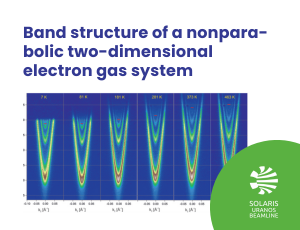
 Web Content Display
Web Content Display
SOLARIS centre
 Web Content Display
Web Content Display
 Web Content Display
Web Content Display
Research on two-dimensional electron gas (2DEG) formed on a tellurium-passivated InAs(110) surface

Researchers from the Faculty of Physics, Jagiellonian University, in close collaboration with URANOS scientists, have studied a two-dimensional electron gas (2DEG) formed on a tellurium-passivated InAs(110) surface. High-resolution ARPES measurements have been performed as a function of temperature and 2DEG sheet density, to study the many-body interactions within the 2DEG. The band shapes and their widths have been discussed in detail.
Figure 1. A set of ARPES spectra for 2DEG on a Te/InAs(110) acquired at a few different temperatures
Thanks to their unusual and useful properties, 2DEG systems are the workhorse of contemporary digital electronics. Recently they also gain an increasing interest in the context of proposed devices for spintronics and quantum computing.
In contrast to the traditional approach in which 2DEGs are created at the interface between two materials (e.g. GaAs/AlGaAs) the researchers have fabricated 2DEG at the surface of an InAs semiconductor, where it is exposed to be studied with the ARPES method.
Figure 2. InAs surface ARPES spectra’s measured at several photon energies.
The measurements performed at SOLARIS allowed for a detailed analysis of 2DEG on InAs(110) including the many-body effects. The ARPES spectra’s acquired at different temperatures reveal the electron-phonon interaction constant: λe-ph=0.034(2). Electron-electron interactions are found to be weak and obscured by the electron-donor interactions. The many-body renormalizations of the electronic bands are negligible, so that the many-body effects manifest only by the electronic band widths.
One-electron Schrödinger-Poisson calculations including also the Thomas-Fermi approximation (SP/TF) have been used to successfully describe the 2DEG bands. It has been also shown that the band shapes resemble closely the so called Kane bands indicating the physical significance of the Kane kp model for the description of the investigated system.
Figure 3. 2DEG experimental bands (blue dots) and different theoretical model lines. Of note are the Kane model lines (black), coinciding with the SP/TF lines (magenta) and with the experimental data.
Written by: Dawid Wutke, Jacek J. Kołodziej
The publication can be found here:
D. Wutke, M. Garb, A. Krawczyk, A. Mielczarek, N. Olszowska, M. Rosmus, J. Kolodziej Band structure of a nonparabolic two-dimensional electron gas system, Physical Review B, 107 (15), 155139(2023) doi: 10.1103/PhysRevB.107.155139
